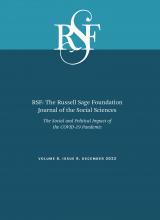Research Article
Open Access
The Presentation of Self in Virtual Life: Disinformation Warnings and the Spread of Misinformation Regarding COVID-19
Kevin T. Leicht, Joseph Yun, Brant Houston, Loretta Auvil, Eamon Bracht
RSF: The Russell Sage Foundation Journal of the Social Sciences December 2022, 8 (8) 52-68; DOI: https://doi.org/10.7758/RSF.2022.8.8.03
Kevin T. Leicht
aProfessor and past chair of the Department of Sociology at the University of Illinois Urbana-Champaign, United States
Joseph Yun
bArtificial intelligence and innovation architect and research professor of electrical and computer engineering at the University of Pittsburgh, United States
Brant Houston
cProfessor and the John S. and James L. Knight Foundation Chair in Investigative and Enterprise Reporting at the University of Illinois at Urbana–Champaign, United States
Loretta Auvil
dThe National Center for Supercomputing Applications at the University of Illinois at Urbana-Champaign, United States
Eamon Bracht
ePh.D. student in the School of Information Sciences Informatics Program at the University of Illinois at Urbana-Champaign, United States

REFERENCES
- ↵
- Barratt, Stephen
- ↵
- Baud, David,
- Xiaolong Qi,
- Karin Nielsen-Saines,
- Didier Musso,
- Léo Pomar, and
- Guillaume Favre
- ↵
- Beer, Thomas
- ↵
- boyd, danah
- ↵
- boyd, danah
- ↵
- Brennan, Scott,
- Felix M. Simon,
- Philip N. Howard, and
- Rasmus Kleis Nielsen
- ↵
- ↵
- ↵
- Burns, Andrew, and
- Kat Albrecht
- ↵
- Carpenter, Timothy
- ↵
- Cohen, Alison K.,
- Rachel Brahinsky,
- Kathleen M. Coll, and
- Miranda P. Dotson
- ↵
- Coker, Ann L.,
- Heather M. Bush,
- Bonnie S. Fisher,
- Suzanne C. Swan,
- Corrine M. Williams,
- Emily R. Clear, and
- Sara DeGue
- ↵
- Confessore, Nicholas
- ↵
- Doctors Without Borders
- ↵
- Dunn Tenpas, Kathryn
- ↵
- Dunn Tenpas, Kathryn
- ↵
- Eagly, Alice H., and
- Shelly Chaiken
- ↵
- Epley, Nicholas, and
- Thomas Gilovich
- ↵
- Evans, Laura E.,
- Raymond Foxworth,
- Gabriel R. Sanchez,
- Cheryl Ellenwood, and
- Carmela M. Roybal
- ↵
- ↵
- Fallis, Don
- ↵
- Fen, Christina
- ↵
- French, Martin, and
- Torin Monahan
- ↵
- Friedman, Lisa, and
- Brad Plumer
- ↵
- Fung, Brian
- ↵
- Gentzkow, Matthew
- ↵
- Ghenai, Amira, and
- Yelena Mejova
- ↵
- Gibbs, Alexandra
- ↵
- Glenza, Jessica
- ↵
- Goffman, Irving
- ↵
- Gowen, Annie,
- Juliet Eiloerin,
- Ben Guarino, and
- Andrew Ba Tran
- ↵
- Graves, Lisa
- ↵
- Hitlin, Paul,
- Lee Raine, and
- Kenneth Olmstead
- ↵
- ↵
- James, Sarah,
- Caroline Tervo, and
- Theda Skocpol
- ↵
- Jernigan, David H., and
- Anne E. Rushman
- ↵
- Jurkowitz, Mark, and
- Amy Mitchell
- ↵
- Kamp Dush, Claire M.,
- Wendy D. Manning,
- Miranda N. Berrigan, and
- Rachel R. Hardeman
- ↵
- Kavanagh, Jennifer, and
- Michael D. Rich
- ↵
- Kleinhesselink, Randall R., and
- Richard E. Edwards
- ↵
- Kunda, Ziva
- ↵
- Lazer, David,
- Matthew A. Baum,
- Yochai Benkler,
- Adam J. Berinsky,
- Kelly M. Greenhill,
- Filippo Menczer,
- Miriam J. Metzger, et al
- ↵
- ↵
- Leicht, Kevin T., and
- Mary Fennell
- ↵
- Leicht, Kevin T.,
- Joseph Yun,
- Brant Houston, and
- Loretta Auvil
- ↵
- Leicht, Kevin T.,
- Joseph Yun,
- Brant Houston,
- Loretta Auvil,
- Peter Ondish,
- James Evans, and
- Prassana Balpradesh
- ↵
- Lewis, Kevin,
- Jason Kaufman, and
- Nicholas Christakis
- ↵
- Lord, Charles G.,
- Lee Ross, and
- Mark R. Lepper
- ↵
- Marcon, Alessandro R.,
- Blake Murdoch, and
- Timothy Caulfield
- ↵
- Marwick, Alice E., and
- danah boyd
- ↵
- McCloskey, Brian, and
- David L. Heymann
- ↵
- McPherson, Karla
- ↵
- Mendelson, Andrew, and
- Zizi Papacharissi
- ↵
- Morse, Jack
- ↵
- Nichols, Tom
- ↵
- Nyhan, Brendan, and
- Jason Reifler
- ↵
- Pears, Emily, and
- Emily Sydnor
- ↵
- Pennycook, Gordon,
- Jonathon McPhetres,
- Yunhao Zhang,
- Jackson G. Lu, and
- David G. Rand
- ↵
- ↵
- Pezzia, Carla,
- Magda C. Rogg, and
- Tammy Leonard
- ↵
- Quan-Haase, Annabelle, and
- Jessica L. Collins
- ↵
- ↵
- Redbird, Beth,
- Laurel Harbridge-Yong, and
- Rachel Davis Mersey
- ↵
- Robi, Jill
- ↵
- Robinson, Laura
- ↵
- Rose, Jonathan
- ↵
- ↵
- Schaffner, Brian F., and
- Cameron Roche
- ↵
- Schild, Leonard,
- Chen Ling,
- Jeremy Blackburn,
- Gianluca Stringhini,
- Yang Zhang, and
- Savvas Zannettou
- ↵
- Schroeder, Ralph
- ↵
- Spinney, Laura
- ↵
- Suciu, Peter
- ↵
- Suhay, Elizabeth,
- Aparna Soni,
- Claudia Persico, and
- Dave E. Marcotte
- ↵
- Taber, Charles S., and
- Milton Lodge
- ↵
- ↵
- ↵
- Vogel, Wendy
- ↵
- Vraga, Emily K., and
- Leticia Bode
- ↵
- Yun, Joseph T.,
- Utku Pamuksuz, and
- Brittany R. L. Duff
In this issue
The Presentation of Self in Virtual Life: Disinformation Warnings and the Spread of Misinformation Regarding COVID-19
Kevin T. Leicht, Joseph Yun, Brant Houston, Loretta Auvil, Eamon Bracht
RSF: The Russell Sage Foundation Journal of the Social Sciences Dec 2022, 8 (8) 52-68; DOI: 10.7758/RSF.2022.8.8.03
The Presentation of Self in Virtual Life: Disinformation Warnings and the Spread of Misinformation Regarding COVID-19
Kevin T. Leicht, Joseph Yun, Brant Houston, Loretta Auvil, Eamon Bracht
RSF: The Russell Sage Foundation Journal of the Social Sciences Dec 2022, 8 (8) 52-68; DOI: 10.7758/RSF.2022.8.8.03
Jump to section
Related Articles
- No related articles found.
Cited By...
- No citing articles found.





